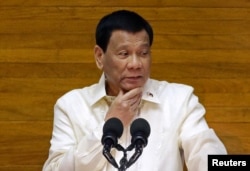The resource-rich Philippines is doubling up development of its own fuel sources as world oil price hikes hit the largely impoverished population.
On October 17, Philippine President Rodrigo Duterte signed a service contract with the Israeli energy exploration firm Ratio Petroleum to scout for fuel under the South China Sea, the Department of Energy in Manila said. It is the first Philippine-foreign energy contract signed since 2013.
The Philippines is talking separately with China, despite a maritime sovereignty dispute, about another joint exploration deal.
Pursuit of joint exploration with foreign countries reflects not only a lack of technological expertise in the Philippines to exploit its own undersea fuel reserves, but also an urgency to find that fuel, experts believe.
“It’s ideal to probably have a good source of oil,” said Jonathan Ravelas, chief market strategist with Banco de Oro UniBank in Metro Manila. “It would be ideal if we can be self-sufficient. It would save money given the rising oil price.”
Price-sensitive consumers
Oil price hikes have rippled around the world this year but hit the Philippines especially hard because food staples such as rice have suddenly started costing more at the same time. Inflation was 6.4 percent August, the highest in Southeast Asia, and 6.7 percent in September.
About one-fifth of the 100 million-plus Philippine population lives in poverty, meaning some feel a pinch when they get gasoline for their motorcycles or buy tickets for public transport.
Duterte, an otherwise popular president, saw his net trust rating fall from 75 to 57 points from December through June in part because of inflation, analysts believe.
Prices for Brent crude oil hit $78.90 per barrel on the world market in September, up from $72.50 a month earlier, for a 40 percent increase over the previous year. Sino-U.S. trade disputes and a cut in oil export loading by Iran have driven the increases.
“The President has been very clear – our country needs to attain energy security and sustainability at the soonest possible time,” energy department Secretary Alfonso Cusi said via his department’s website last week.
“We are currently experiencing how our dependence on importation has left us at the mercy of price movements in the global oil markets,” he said. “We need to boost the exploration and development of our own energy resources and the awarding of the petroleum service contract to Ratio Petroleum is a step in the right direction.”
Oil and gas exist; expertise lags
The Philippines controls untapped fuel deposits estimated at $26.3 trillion, the state-run Philippine News Agency said in February, calling that amount “more than enough to free the country from the shackles of poverty.”
But its contractors lack the exploitation expertise available in Western countries, analysts believe. In Asia, Vietnam and Myanmar also rely on foreign partners to tap fuel under the sea.
“Often these frontier economies don’t have good capabilities in that area,” said Rajiv Biswas, executive director and Asia-Pacific chief economist with the research firm IHS Markit.
“Definitely oil and gas technology is a key area where developing countries, especially countries like the Philippines, need the help of big global players who have advanced technology in oil and gas,” Biswas said. Developing countries may also need the foreign contractor’s investment, he added.
Manila is no stranger to foreign oil exploration deals, but deals can be elusive because estimated reserves are not on the scale of places such as the Middle East, while parts of the South China Sea west of the Philippine archipelago are contested. Five other governments claim all or part of the same waters.
Philippine officials brought on Shell Philippines Exploration, a subsidiary of Royal Dutch Shell, in 2002 to help explore a major undersea tract called the Malampaya gas field. Gas from that field accounts for 20 percent of domestic electricity requirements but Philippine media say reserves are forecast to start declining by 2022.
China and the Philippines have talked about joint oil exploration since 2017, with China saying it would be willing to accept just a 40 percent share of any discoveries. The two sides still dispute sovereignty in parts of the South China Sea, but since 2016 officials from both have set the dispute aside to work together economically.
The Israeli firm is untested so far, analyst say, but it should pay attention to potential competition. The 7-year contract calls for tapping 416,000 hectares in an undisputed zone for potential oil and gas.
“If they want to get more oil exploration projects in the Philippines, they better measure up, because China is coming in,” said Eduardo Araral, Philippine and South China Sea-specialized associate professor at the National University of Singapore’s public policy school.







